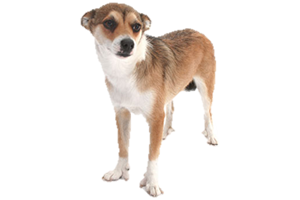Norwegian Lundehund
Norsk Lundehund, Norwegian Puffin Dog

The Norwegian Lundehund was developed specifically to hunt puffins on remote islands of the coast of northern Norway. They would have to climb up cliffs to the nests of fledglings, retrieve the birds and return them unharmed to their waiting hunter. Each individual dog brought down on average 20-40 birds and as many as 80. It is the only dog breed that is polydactyl, it has at least six toes per paw and that is not their only unique feature. Their ears can fold over to help protect their head from rain and wind as it climbs cliffs and in order to be able to get through small crevices their forelegs can move sideways at a 90 degree angle, while their neck is double jointed.
Norwegian Lundehund Standards
- 12-16"
- 12-14 lbs
- small spitz breed
- triangular, prick ears
- medium length tail, may curl when moving
- coat is harsh, dense, and straight
- black with white markings
- grey with white markings
- reddish-brown to fallow with white markings
- white with dark patches
History of the Norwegian Lundhund
The Norwegian Lundehund was used from the 16th to 19th century, but when puffins became protected in the 1800s their numbers began to decline dramatically. More remote areas on the island of Vaeroy became their stronghold and in the 1930s Eleanor Christie took an interest in the breed and acquired some breeding stock she took back to the mainland. Her dogs became the breed’s salvation when distemper broke out on the island in 1943 and killed all but one dog. Christie sent some of her own dogs back to the island, which saved them again when distemper hit her own kennel the following year. After WWII she obtained more dogs from the small remaining island stock and revived the breed.
